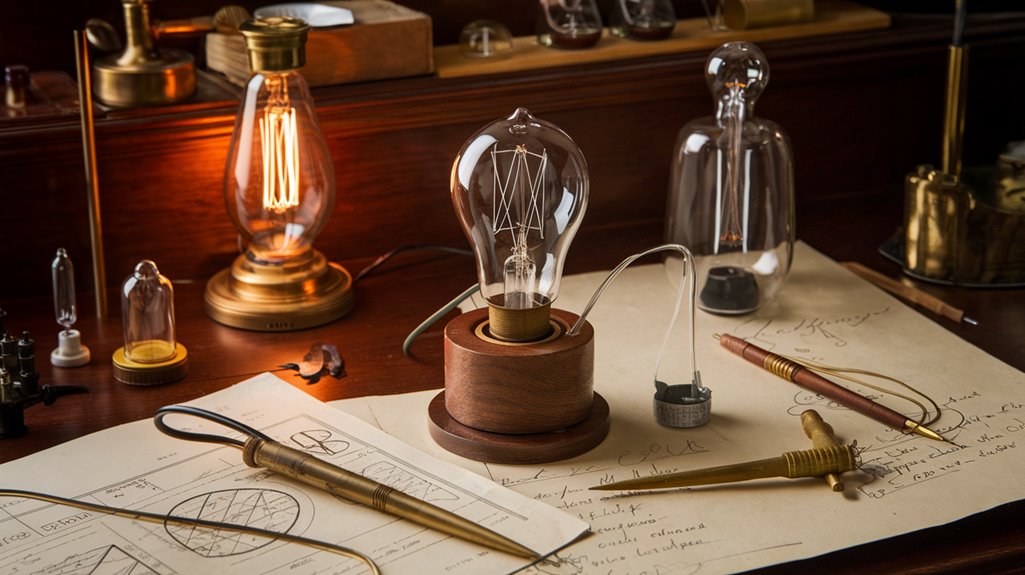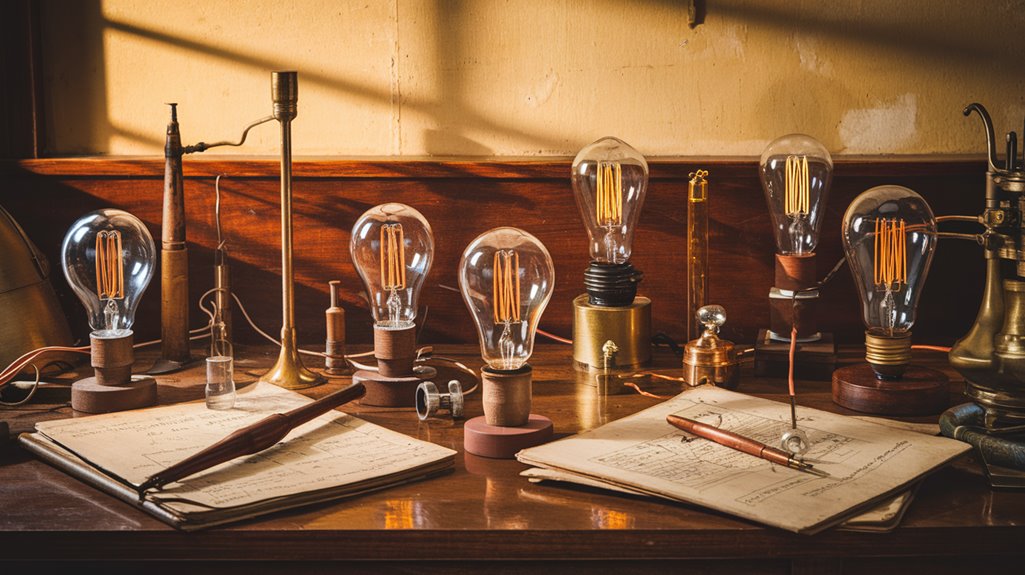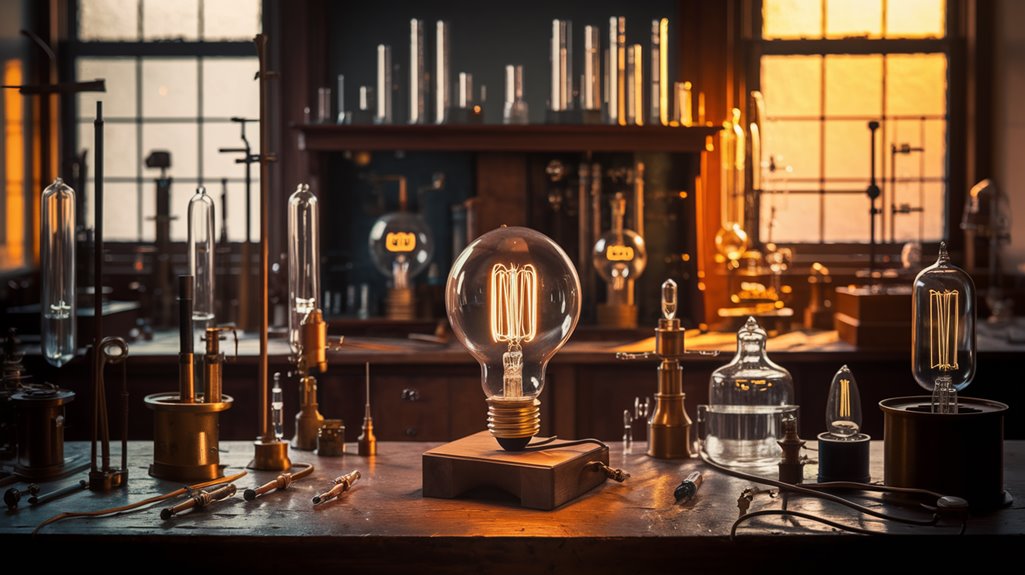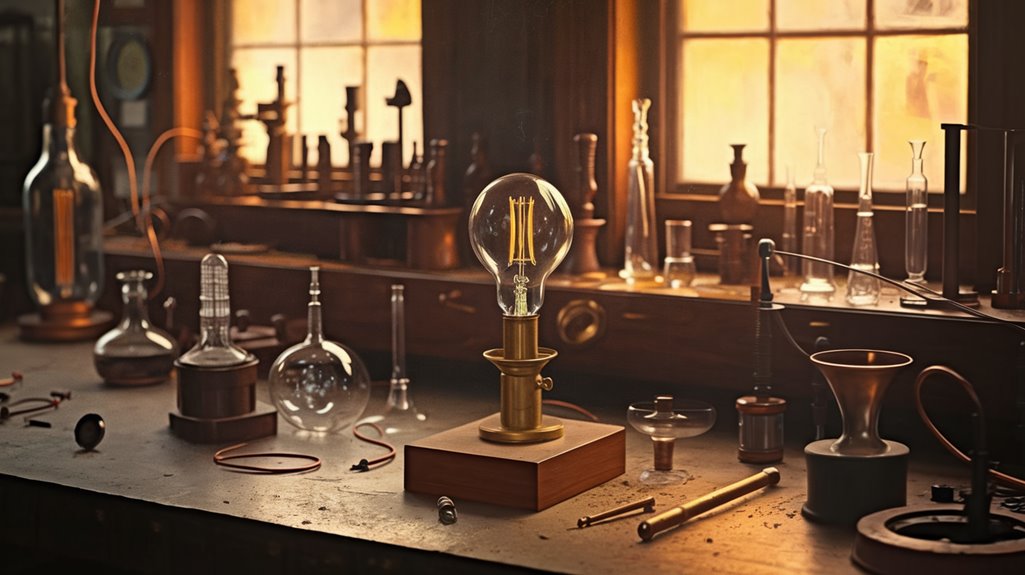Thomas Edison Didn’t Actually Invent the Light Bulb
Just as you might have several light bulbs burn out in your home at once, the popular belief that Thomas Edison invented the light bulb has also dimmed with time. You've probably heard the standard narrative: Edison had a brilliant idea and changed the world overnight. But that's not quite how it happened. The real story involves multiple inventors, decades of innovations, and a complex path to creating the modern electric light that you'll want to understand.
The Origins of Electric Light Before Edison

While many associate the light bulb solely with Thomas Edison, the journey toward electric lighting began decades before his innovations.
You can trace the first early electric experiments back to 1799 when Alessandro Volta created the voltaic pile, the first electric battery that could heat copper wire until it glowed.
Soon after, Humphry Davy made significant strides with arc lighting advancements, demonstrating the first electric lamp exceeding 10,000 lumens at the Royal Society in 1809.
Through the following decades, inventors like Warren de la Rue, James Bowman Lindsay, and William Greener contributed essential developments in electric lighting technology. Edison's eventual success came from using carbonized bamboo filament that could last over 1,200 hours.
By 1878, Joseph Swan had already patented an evacuated carbon filament lamp before Edison's involvement. One key advancement was de la Rue's creation of an electric light using a platinum coil in a vacuum tube in 1840.
These pioneering achievements laid the fundamental groundwork for the modern electric light.
Joseph Swan's Groundbreaking Carbon Filament Research
Among the early pioneers of electric lighting, Joseph Swan stands out for his methodical approach to carbon filament development.
You'll find his journey began in 1850 when he started experimenting with carbonized paper filaments in evacuated glass bulbs. While he demonstrated a working device by 1860, it wasn't until the 1870s that his carbon filament innovations truly took shape. He focused extensively on plant-based materials to create more durable and structurally sound filaments.
Swan's breakthrough came from combining improved vacuum pumps with carbonized thread filaments, leading to his landmark demonstration at Newcastle's Chemical Society in 1878. His dedication to advancing technology earned him a knighthood in 1904 for his remarkable contributions to science.
Edison's Path to Commercial Success
Two critical factors set Thomas Edison apart in his quest to commercialize the light bulb: his systematic approach to innovation and his keen business acumen.
With strong financial backing, he assembled a skilled team at Menlo Park to methodically test over 6,000 materials until they discovered carbonized bamboo as the ideal filament. The development process cost USD 40,000 to achieve success. These bulbs were revolutionary, lasting between 600 and 1,200 hours.
Edison's teamwork approach proved essential as his researchers tackled multiple challenges simultaneously. They developed better vacuum pumps, improved insulation for underground wiring, and created powerful dynamos for the electrical system.
The True Nature of Edison's Achievement
Although many people credit Edison with inventing the light bulb, his true achievement lies in refining and commercializing existing technology.
You'll find that Edison's innovations focused on solving practical problems that prevented widespread adoption of electric lighting.
Through extensive filament development, he tested over 6,000 materials before discovering that bamboo-derived carbon filaments could last up to 1,200 hours.
His team improved vacuum pump technology and tackled issues like oxidation and short-circuiting.
While others had created incandescent lamps before him, including Joseph Swan, Edison's reputation as a technical founder rather than an original inventor accurately reflects his approach to innovation. British courts ruled against Edison in Swan's patent lawsuit.
He developed a complete electrical distribution system, including power stations and street wiring, that would make electric lighting accessible to everyone.
This systematic approach transformed a scientific curiosity into a practical, everyday technology.
How Multiple Innovators Shaped Modern Lighting

When you trace the evolution of modern lighting, you'll discover a rich tapestry of innovations spanning over a century before Edison's breakthrough.
Early inventors like Alessandro Volta and Humphry Davy laid the groundwork with their voltaic pile and electric arc lamp experiments. By the mid-1800s, pioneers such as James Bowman Lindsay, Warren de la Rue, and Marcellin Jobard advanced the technology through their work with carbon filaments and vacuum atmospheres. Gas lamp fixtures were widely used during this period, marking the true beginning of architectural lighting. Lewis Latimer made significant improvements by developing heat-treating methods that reduced carbon filament breakage.
The lighting evolution gained momentum as Joseph Swan developed a practical design using carbonized cotton thread, while Alessandro Cruto created long-lasting graphite filaments.
These collective achievements culminated in modern innovations like fluorescent lighting, high-intensity discharge lamps, and LEDs. Nick Holonyak Jr.'s invention of the LED in 1962 marked a revolutionary shift toward energy-efficient lighting solutions we use today.










